

11/2005
LRRC gives participants a first chance to speak with one voice
From the moment he opened the Louisiana Recovery and Rebuilding Conference on November 10 in New Orleans, AIA Executive Vice President/CEO Norman L. Koonce, FAIA, told the 600 participants that “the results of our work over the next three days cannot and will not be dictated by outside experts. Success for this conference demands that it must be a collaborative, inclusive, and open process driven by local citizens and leaders of this state. The visions we seek will be yours.”
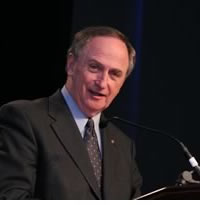 Three
days later, the citizens of Louisiana and the Gulf Region responded to
the challenge, ascertaining foremost that they—and
their political leaders—must “speak with one voice” to
create a single, comprehensive, and compelling regional plan
with participation from the full community, that offers leadership for
recovery and rebuilding.
Three
days later, the citizens of Louisiana and the Gulf Region responded to
the challenge, ascertaining foremost that they—and
their political leaders—must “speak with one voice” to
create a single, comprehensive, and compelling regional plan
with participation from the full community, that offers leadership for
recovery and rebuilding.
Unique process encourages citizen participation
On October 17, after she named her Louisiana Recovery Authority team,
Governor Kathleen Blanco prescribed this conference as one of the top
action items of its agenda. The AIA and its cosponsors—the American
Planning Association, National Trust for Historic Preservation, and
the American Society of Civil Engineers—had three weeks to assemble
the conference, and priority number one was to engage the participants. “The
first thing we did was invite representatives from every city and neighborhood
group we could locate,” said David Downey, Assoc. AIA, managing
director of the Institute’s Center for Communities by Design. “We
asked people from civic associations, school groups, government groups,
church groups, and business associations to participate.”
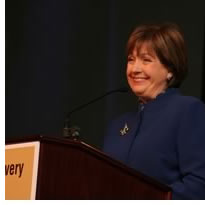 To
assure that those voices could be heard, America Speaks, the nonpartisan,
nonprofit organization that conducts citizen engagement projects, facilitated
twice-daily small-group discussions and guided participants in an electronic “instant
polling” process that allowed each participant’s voice to
be heard. America Speaks, which also facilitated New York City’s
2002 “Listening to the City” 4,300-citizen-strong public
debate about the rebuilding of the World Trade Center site, used the
process to conduct on-site tabulation and analysis of how participants
want the rebuilding to proceed.
To
assure that those voices could be heard, America Speaks, the nonpartisan,
nonprofit organization that conducts citizen engagement projects, facilitated
twice-daily small-group discussions and guided participants in an electronic “instant
polling” process that allowed each participant’s voice to
be heard. America Speaks, which also facilitated New York City’s
2002 “Listening to the City” 4,300-citizen-strong public
debate about the rebuilding of the World Trade Center site, used the
process to conduct on-site tabulation and analysis of how participants
want the rebuilding to proceed.
In between the small-group breakouts, participants heard from speakers who included technical experts from the region and around the globe, as well as Xavier University President Dr. Norman Francis, Gov. Blanco, Lt. Gov. Mitch Landrieu, Senator Mary Landrieu, and Congressional representatives Charles Melançon, Bill Jefferson, and Bobby Jindall. Norman Robinson, the anchor of New Orleans’ WDSU, Channel 6, and a native of New Orleans who brought eyewitness reports to his fellow citizens during the hurricanes, served as emcee for the conference and helped weave together the input from the experts and the feedback from the participants.
 What the people want
What the people want
Over the three days of the conference, a set of core themes began to
emerge, painting a vivid picture of rebuilding concepts. The core themes
include:
1. “Speak with one voice” . . . create a single, comprehensive, and compelling regional plan, with participation by the full community, that offers leadership for recovery and rebuilding.
2. Create infrastructure that supports recovery by restoring confidence, enhancing quality of life, and withstanding future disasters:
 Category 5 protection—levees, restored
wetlands, and an independent authority to insure ongoing maintenance
and funding
Category 5 protection—levees, restored
wetlands, and an independent authority to insure ongoing maintenance
and funding- Improved services, such as communications, energy, and other key elements
- Sustainable, equitable, and transparent approaches to rebuilding and future development
3. Promote economic growth that benefits everyone:
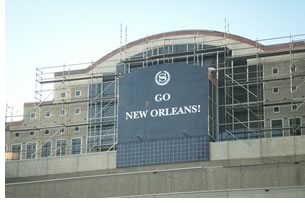 A diverse economy encompassing traditional
and emerging industries, supported by both respect for the region’s
historic character and innovative funding strategies (incentives
and public/private partnerships)
A diverse economy encompassing traditional
and emerging industries, supported by both respect for the region’s
historic character and innovative funding strategies (incentives
and public/private partnerships)- A foundation for growth, including quality education and job training, housing, transportation, and other key elements available regardless of income
- Equity that includes living wages and career tracks, benefits everyone in the region, and provides long-term economic opportunity
4. Provide public services that enhance quality of life for everyone:
- High-quality education at every level as a center for rebuilding communities
- Regional transit, coordinated with opportunities for community development
- Great parks and other public spaces that serve communities and support flood control
5. Pursue policies that promote a healthy environment and healthy people:
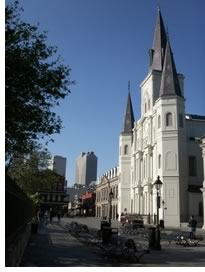 Deciding where to rebuild, investing
in protecting these areas, and dedicating remaining areas to natural
uses
Deciding where to rebuild, investing
in protecting these areas, and dedicating remaining areas to natural
uses- Sustainable approaches to every facet of rebuilding—energy, transit, land use, building design, and other elements
- Walkable communities that promote healthy lifestyles through their planning and design
6. Plan and design communities that advance livability:
- Preserving the best of the past as the core for rebuilding while anticipating future needs
- Mixed-income, mixed-use neighborhoods that foster diversity and social equity
- Smart growth at an urban, suburban, and rural scale that balances recovery and sustainability.
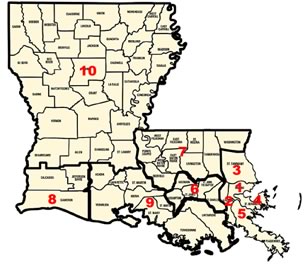 On
the final day of the conference, participants grouped themselves into
parishes to explore answers to two specific questions: “What
is special and unique to our parish?” and “What changes would
we like to see in our parish?” Each group also generated a list
of parish-specific principles for rebuilding. The groups, as indicated
on the map below, were: Orleans Parish (1) Jefferson Parish (2), St.
Tammany Parish (3), Baton Rouge/ Florida and Central/ Northern Parishes
(7 & 10), Plaquemines/St. Bernard Parishes (4 & 5), South Coast
Parishes (6, 8 & 9), and Other. The feedback is rich and varied,
with calls for strong historic preservation efforts, comprehensive transit
networks, neighborhood health-care clinics, a wildlife preserve, co-located
permitting offices, schools “raised to the top quartile by 2015,” and
many other visioning plans. While the feedback is being compiled into
a final set of recommendations, the complete list of preliminary findings
from the parishes is available on the
LRRC Web site.
On
the final day of the conference, participants grouped themselves into
parishes to explore answers to two specific questions: “What
is special and unique to our parish?” and “What changes would
we like to see in our parish?” Each group also generated a list
of parish-specific principles for rebuilding. The groups, as indicated
on the map below, were: Orleans Parish (1) Jefferson Parish (2), St.
Tammany Parish (3), Baton Rouge/ Florida and Central/ Northern Parishes
(7 & 10), Plaquemines/St. Bernard Parishes (4 & 5), South Coast
Parishes (6, 8 & 9), and Other. The feedback is rich and varied,
with calls for strong historic preservation efforts, comprehensive transit
networks, neighborhood health-care clinics, a wildlife preserve, co-located
permitting offices, schools “raised to the top quartile by 2015,” and
many other visioning plans. While the feedback is being compiled into
a final set of recommendations, the complete list of preliminary findings
from the parishes is available on the
LRRC Web site.
What do we do now?
Koonce, and W. Paul Farmer, executive director and CEO of the American
Planning Association, wrapped up the program on Saturday evening with
a list of suggested actions, assembled by the sponsoring groups, to
further the good work of the conference. Specifically, “on the
basis of what you have said,” Koonce remarked, “we suggest
that you”:
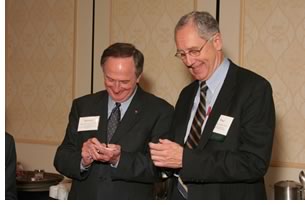 Call for a single entity to lead the state’s
recovery efforts
Call for a single entity to lead the state’s
recovery efforts- Work to make sure that all actions—federal, state and local—embrace and embody the principles you have identified as important to the rebuilding effort
- Ask the Louisiana Recovery Authority and local planning efforts to make sure that they engage professionals who will implement the principles of this conference, and that they are applied statewide, regionally, and in each community.
As a group, the collaborating organizations say that they will:
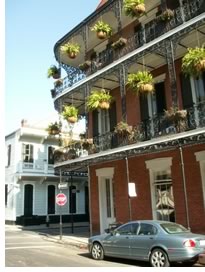 Present principles to the Louisiana Recovery Authority, the
Bring Back New Orleans Commission, and all other local entities
Present principles to the Louisiana Recovery Authority, the
Bring Back New Orleans Commission, and all other local entities - Support the efforts of Louisiana’s congressional delegation, the state of Louisiana, and local officials, to develop a unified, consolidated federal legislative action plan that will secure immediate commitments from the federal government
- Maintain a strong public information effort
- Meet with Don Powell, the president’s coordinator on rebuilding efforts
- Urge the LRA to make a commitment to ensure that all parish disaster mitigation plans are completed by August 29, 2006
- Seek legislation to move principles forward so that recovery and rebuilding are facilitated, consistent with those principles
- Make video proceedings available
- Publish principles (Web and print) and see that they are widely distributed
- By the end of the next week make presentations from this conference available on the Web
- Translate principles into practical actions that can be implemented.
Finally,
We can:
- Take our principles and present them with the same passion and commitment to everyone
 Secure
approval of a unified state building
code.
Secure
approval of a unified state building
code.
We will:
- Bring others into this conversation
- Demand congressional action
- Demand/call for one voice on rebuilding, a voice that follows the principles.
AIA Louisiana President Trula Remson, AIA, closed the conference with thanks to participants and a pledge from the chapter to keep the conference’s momentum moving efforts forward.
Copyright 2005 The American Institute of Architects.
All rights reserved. Home Page ![]()
![]()
